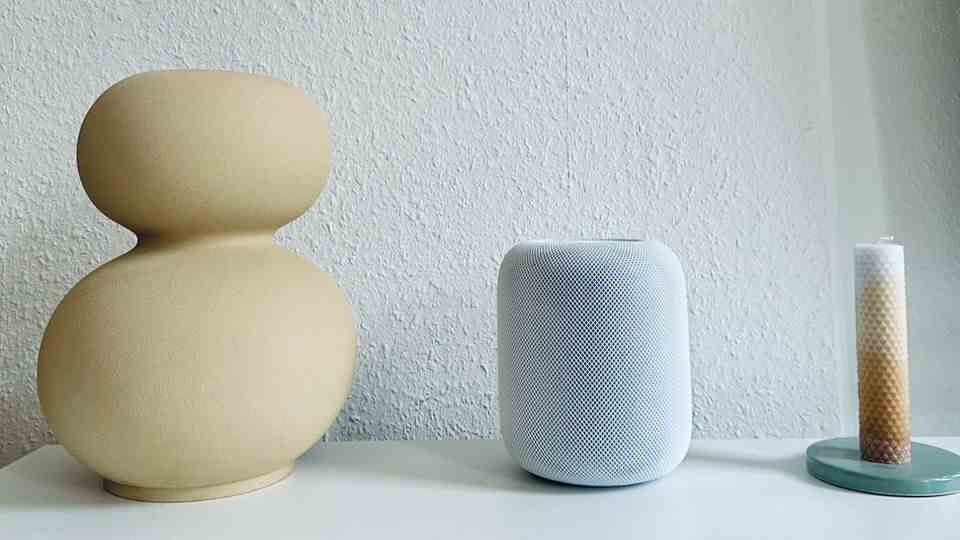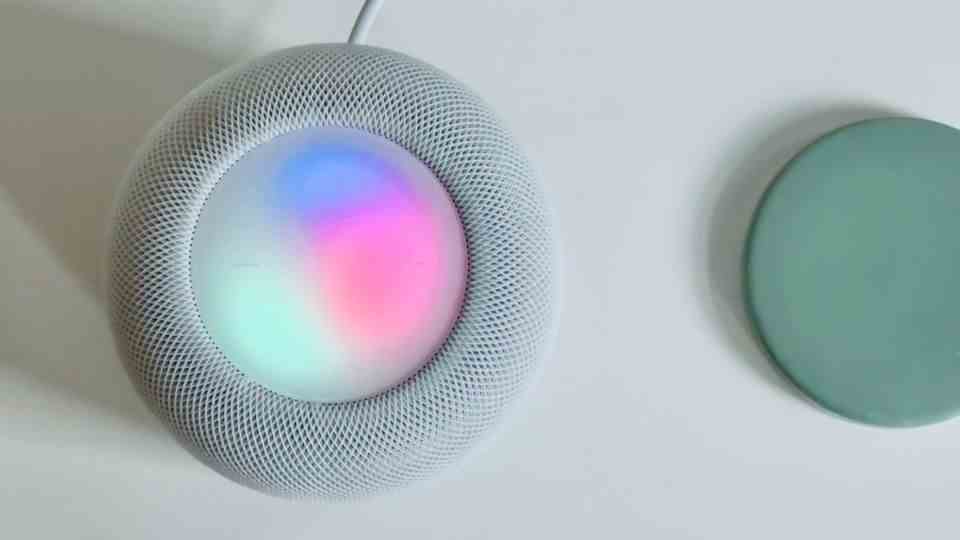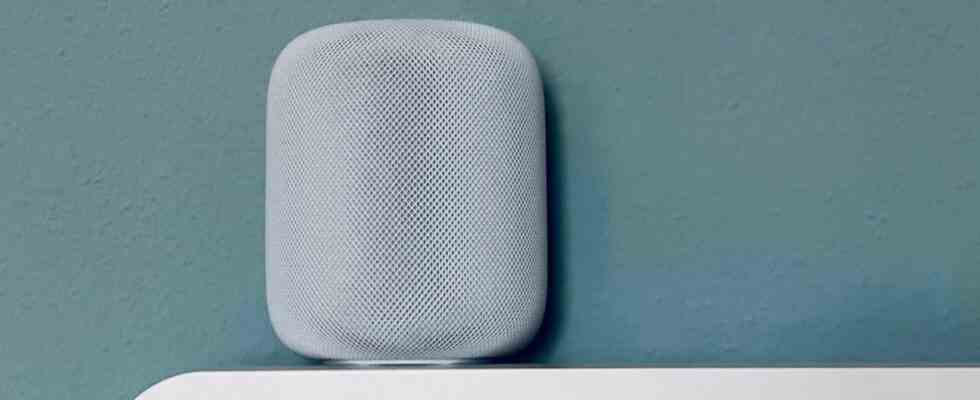It’s been two years since Apple retired its smart Homepod speaker. Now there is a new model. This proves to be significantly better than the predecessor in the test. However, the two biggest weaknesses remain.
The quiet violin can be heard barely perceptibly from the left, then a cautious flute joins in on the right. The drumbeat sounds – and the orchestra fills the room. But if you listen carefully, you can still tell where the individual musicians are distributed in the hall: the new Homepod makes the instruments sound from different directions. And makes the music almost tangible.
Until recently, it was anything but foreseeable that Apple would try it again in the living room. The first Homepod presented in 2018 (tested here by us) was convincing in terms of design and sound, but it was not a sales success. Apple took the consequence: From March 2021, the large model was taken out of the market and only the Homepod Mini was sold. Now you dare a second attempt with the new Homepod. And manages to surpass itself in the test.
It’s the intrinsic value that counts
The basic principle of the predecessor remains the same: the Homepod is still a great-sounding speaker with the support of Apple’s voice assistant Siri, which can be set up very easily via a connected iPhone or iPad. As with the first device, Apple relies on a simple look with a rounded cylinder covered by a mesh network. But that’s also completely fine: the design is still very chic, in black or white it looks great even in stylish apartments.
Inside, however, a lot has happened. On the one hand, the built-in S7 chip ensures even faster implementation of voice commands. On the other hand, Apple has significantly revised the speakers. On the one hand there is the thick woofer, which fills almost the entire core of the Homepod. It is supported by five tweeters arranged in a circle at the bottom edge. And so distribute the sound in the room.

The chic design also goes with the modern Scandinavian look
© Malte Mansholt / star
Sound fed up
The result is impressive. The warm sound fills larger rooms effortlessly. The bass is unexpectedly rich given the small body, but doesn’t crush the finely worked out mids and highs. Whether filigree classic, driving rock or booming R’n’B: The Homepod does them all justice.
This is also due to the fact that Apple doesn’t just leave it at the dumb blowing out of the music. The Homepod uses microphones to capture its surroundings and adapts accordingly to the circumstances. Not only the room and objects in it are considered, but also the temperature of the device. Complex algorithms are then used to calculate which tweeter sounds in which direction and how loudly.
This not only ensures that the sound is always adapted. As the first Apple device, the Homepod can also produce 3D sound in standalone mode if the media being played supports it. In specially mixed playlists on Apple Music, you can then hear the orchestra distributed throughout the room as described above, and there are also dozens of current hits in the room sound. A great effect.
Even better in doubles
However, this is implemented even better if you use two of the new Homepods at the same time. If you set up a second device, it automatically recognizes the first Homepod in the home network and then offers to connect them as a stereo pair. The effect is impressive. Not only do the two homepods then share the stereo sound among themselves. The 3D effect is also significantly enhanced. And: The bass gets noticeably more pressure. In the test, the two homepods were able to compete with a Sonos Playbar with the associated mini subwoofer.
The 3D effect is especially fun when you connect a pair of Homepods to an Apple TV (see our review of the latest model here). The two loudspeakers then take over the TV sound and even master surround sound. This works excellently in media optimized for this, such as the Apple series “See”. Even with your eyes closed, you could immediately locate the location of the blind main characters.
Although two homepods cannot completely replace a surround system, rear speakers are still more convincing. Nevertheless, the effect is very good. Great: If your own TV system is Airplay-capable, as is the case with Sonos systems, you can also pair it with the Homepod and select both at the same time. This also works with music, by the way. The only downside: In both cases you have to keep selecting the pairing in the Airplay menu.
Apple dependent
Compared to systems that can be used in general, such as Sonos, however, the Homepod has one major shortcoming: the Apple speakers can only be used if you are already using Apple devices such as an iPhone or iPad. They refuse to work with Android devices. Unfortunately, this makes them much less interesting for many potential buyers.
However, if you are rooted in Apple’s ecosystem, there is no other such deeply integrated smart speaker. If you call up Apple’s language assistant either by tapping on the touch surface or by typing “Hey Siri”, you have access to all Apple offers such as the iMessage chat service, calls via FaceTime audio or even the calendar, notes or reminders.

Apple’s assistant Siri shows that she’s listening with a light on the top-mounted touchscreen
© Malte Mansholt / star
smart home
The Homepod keeps an eye out for who is talking to it. Siri can automatically recognize up to five voices in the household. This works very well in the test. Reminders created via Homepod automatically ended up in the correct account. If Siri did not know a voice, this was immediately pointed out. Then you have to set it up via the associated Apple account.
Apple has also pimped the Homepod in relation to the smart home. It not only supports the Apple Homekit standard, but also the modern Matter Homekit standard. The new Homepod is pleasantly fast. In the past, you sometimes had to wait a few seconds for implementation, but now the light switches on with practically no delay when called upon.
year in review
Apple reveals: These were the most popular apps of the year in Germany
The older Homepods also get two of the most exciting innovations: Apple now allows access to the built-in thermometer and the humidity transmitter. They are actually intended for the sound calculation, but can now also be used for home routines. For example, to keep the temperature in the room at a desired level at certain times. All Homepods with an update are also capable of recognizing smoke alarms – the Homepod then sends a warning message to the linked iPhone.
Then there is the biggest drawback: the price. With an RRP of 350 euros, the new Homepod is significantly more expensive than smart speakers from competitors Google or Amazon. For many customers, this may simply be too expensive. Realistically, however, one has to say: the sound is definitely worth it. In a stereo pair, the Homepod can also outperform more expensive Sonos soundbars like a Playbase. And the price is even lower. If you want to pay less, you can get most of the smart home functions with the cheaper Homepod Mini.
Conclusion: A strong comeback
With the new Homepod, Apple dares another attempt – and relies fully on the old strengths. And with success. The sound is awesome, especially in a double pack, it’s hard to beat for the price. The 3D sound and the surprisingly rich bass inspire. The simple setup and well-functioning smart home functions are other strengths that Apple has rightly retained and expanded.
The main arguments against the purchase are the dependence on the Apple ecosystem and the price, which is still quite high compared to other speech loudspeakers. Whether Apple will find enough buyers for the successful new edition this time remains exciting.
The new second-generation Homepod will be available in black and white from February 3rd and will cost 349 euros.

